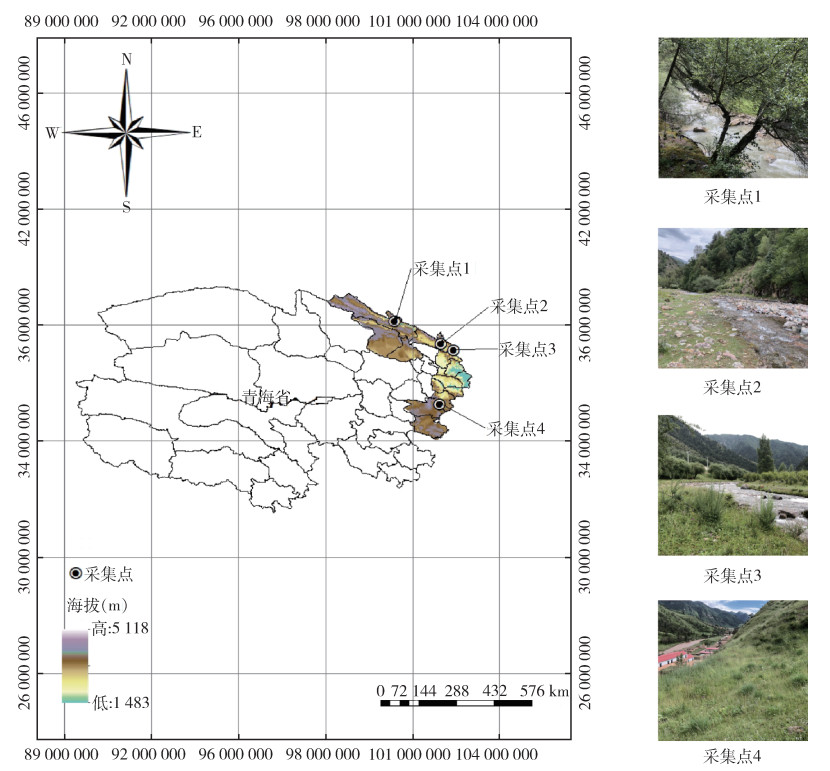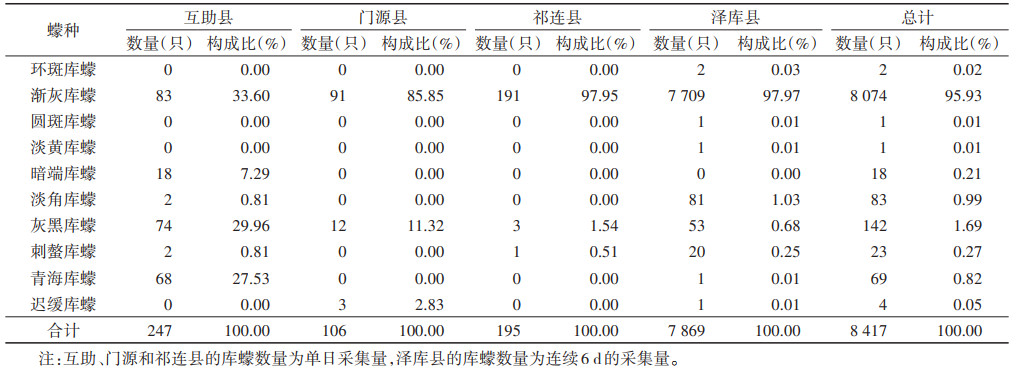扩展功能
文章信息
- 王壮飞, 卢雪, 侯晓晖
- WANG Zhuang-fei, LU Xue, HOU Xiao-hui
- 青海省东部4县库蠓分布调查
- Distribution of Culicoides in four counties of eastern Qinghai province, China
- 中国媒介生物学及控制杂志, 2023, 34(1): 53-57
- Chin J Vector Biol & Control, 2023, 34(1): 53-57
- 10.11853/j.issn.1003.8280.2023.01.010
-
文章历史
- 收稿日期: 2022-08-25
库蠓为双翅目蠓科的一种小型嗜血昆虫,全世界现存吸血蠓为4属1 834种[1],其中库蠓超过1 000种[2-3]。在世界范围内,人们已经从蠓虫中分离出50多种虫媒病毒[4-6],包括蓝舌病毒(Bluetongue virus,BTV)、施马伦伯格病毒(Schmallenberg virus,SBV)和非洲马瘟病毒(African horse sickness virus,AHSV),这些病毒主要影响到牛、马、羊等家畜。在过去10年间库蠓作为疾病媒介的作用常常被忽视,这导致蠓媒病毒性疾病的发病率在世界各地都有了大幅的增加,尤其是BTV和SBV的入侵给部分地区农牧业造成了巨大的经济损失[7-10]。因此,加强库蠓种群与分布的监测极为重要。
青海省属于高原大陆性气候,是我国五大牧区之一,温度、降雨、风速等气候条件以及其他因素对蠓虫活动和数量的影响已得到公认[11]。文献记载青海省截至2022年已记录18种库蠓[1-2, 5]。本研究对青海省祁连山国家公园及麦秀自然保护区4个县的库蠓种类及活动进行监测,评估该地库蠓种群密度与气候因素的相关性,为青海省吸血蠓防治和青海省生物多样性研究提供参考。
1 材料与方法 1.1 标本采集时间及地点2020年7-8月对青海省祁连山国家公园及麦秀自然保护区所在的海北和黄南藏族自治州(海北州和黄南州)的互助、门源、祁连和泽库4个县进行库蠓调查,其中8月6-11日在泽库县进行了6 d的连续采集。
1.2 标本采集方法及鉴定使用紫外光诱虫灯进行标本采集,诱虫灯悬挂于牲畜圈舍旁、靠近水源且无其他光源处,避风,诱虫灯距地面高度约1.5 m,于日落时分挂灯、次日早收回。诱捕器在220 V电压下由柴油发电机驱动,被紫外光(波长365 nm)吸引的小型昆虫被一层纱网过滤经风扇吸至下方的纱网中。
采集到的昆虫保存于75%乙醇溶液中,实验室中使用树胶酚封片法制作成玻片标本,根据文献[10]进行形态学鉴定及计数。
1.3 统计学分析使用SPSS 25.0和GraphPad Prism 8.2.1软件对海拔、降水量、日均温度、风速、采集地点与采集库蠓数量进行Pearson相关性检验,P < 0.05表示相关性有统计学意义。
2 结果 2.1 采样点概述本研究中互助、门源、祁连和泽库4县不同采集地点的经纬度、海拔、生态环境等信息见表 1、图 1,其中泽库县2020年8月6-11日的气温、日平均降水量、平均风速等气象数据来自中国气象数据中心(http://data.cma.cn)。

|

|
| 注:采集点1、2、3、4分别是互助、门源、祁连和泽库县。 图 1 青海省4个库蠓采集点的位置及生境 Figure 1 Location and habitat of four Culicoides sampling sites in Qinghai province |
| |
采获库蠓经形态学鉴定均为库蠓属(Culicoides),分属于5亚属10种,其中海北州有3亚属6种,黄南州有4亚属9种。青海省新记录共6种,分别为渐灰库蠓(C. grisescens)、刺螫库蠓(C. punctatus)、迟缓库蠓(C. segnis)、暗端库蠓(C. nigritus)、圆斑库蠓(C. halonostictus)和淡角库蠓(C. pallidicornis)。见表 2。

|
海北州的互助、门源和祁连县3个采集点中渐灰库蠓采获的数量最多,分别为33.60%、85.85%和97.95%,其中互助采集点的灰黑库蠓和青海库蠓所占比例略低于渐灰库蠓,分别为29.96%和27.53%。同时,黄南州的泽库采集点采获的库蠓种类和数量最多,其优势种仍为渐灰库蠓,占比为97.97%。见表 3。
共采集8 417只库蠓标本,其中饱血个体为179只,总吸血率为2.13%,其中渐灰库蠓8 074只,饱血个体为172只,吸血率为2.13%。采获的库蠓标本中饱血个体仅见于互助和泽库县的渐灰库蠓、灰黑库蠓和淡角库蠓3种,其中互助县采获标本中饱血个体数量较少,仅见灰黑库蠓和淡角库蠓2种,平均吸血率为3.14%,而泽库县采获标本的总数多,渐灰库蠓、淡角库蠓和灰黑库蠓的吸血率相差不大,分别为2.23%、1.23%和1.89%。见表 4。

|
互助、门源和祁连县单日采获库蠓的数量分别为247、106和195只,泽库县连续6 d采获库蠓共7 869只,4地的优势种均为渐灰库蠓,其次是灰黑库蠓、淡角库蠓和青海库蠓。
库蠓在海拔2 598~3 011 m区间内的采集量与海拔高度未呈现相关性(R2=0.130,P=0.639)。泽库县采集点的库蠓日采集量与平均温度(R2=0.838,P=0.010)、降水量(R2=0.199,P=0.038)呈负相关(图 2A、B),而与平均风速无相关性(R2=0.059,P=0.641)(图 2C)。

|
| 图 2 2020年7月26日-2020年8月11日青海省泽库县采集库蠓数量与气象因素的相关性分析 Figure 2 Correlation analysis of the number of collected Culicoides and meteorological factors in Zeku county of Qinghai province from July 26, 2020 to August 11, 2020 |
| |
库蠓的分布、寿命与当地的温度和气候条件密切相关[11-14],根据本研究库蠓的采集量与相关因素关联分析,显示仅降水量、平均气温可能会影响单日库蠓的采集量。关于气候条件如何影响库蠓活动,已有研究认为库蠓可适应较冷的气候条件,且温度波动对库蠓的丰度存在影响[12-15],这与本研究的结果一致。近期的研究也发现蠓虫活动起始平均温度为1~3 ℃[16],同时温度波动对库蠓的飞行活动产生影响[17]。此外,还有研究表明温度会影响蠓类成虫的活动[18],瑞典学者进行的一项研究中发现只有在温度高于8 ℃时才能采集到库蠓成虫[19]。本研究中泽库地区调查期间的平均气温在10.8~12.4 ℃,从数据上看采集量与温度呈负相关,但这个结果一方面温度范围变化较小,另一方面还可能受其他因素影响,故库蠓采集量与温度间关系尚待深入研究。
本研究中青海省4县的库蠓采集量相对较低,吸血率仅为1.23%~5.41%,这可能与海拔、降水、温度等多种因素有关。贺晓龙[20]对青海省8地牛、羊血清样品中BTV进行检测,结果在209份血清样品中检出4份阳性样品,该调查结果显示蓝舌病在青海地区呈散发,推测可能与青海省的地理位置和气候有关,但是不排除该病在青海省传播的可能性,仍需对该病的传播媒介——库蠓在青海地区的流行情况进行持续监测。
气候可以影响库蠓对虫媒疾病的传播能力[20],库蠓传播疾病的流行病学调查发现其与气候密切相关,且在高海拔的低温地区库蠓丰度及其传播疾病的发生率也很低。研究发现,蠓虫之所以能够作为虫媒病毒的载体,与其在适当气候条件下可达到庞大的种群数量及其传播方式有关[21-23]。由于本研究仅对2020年7-8月间的库蠓活动进行了调查,尚不足以评估库蠓可能对研究区域病毒的传播风险,还需对青海省吸血蠓流行性进行全面、长期和更大范围的监测。
利益冲突 无
| [1] |
杨定, 李竹, 刘启飞, 等. 中国生物物种名录. 第2卷. 动物. 昆虫(V)双翅目(1) 长角亚目[M]. 北京: 科学出版社, 2020: 119-220. Yang D, Li Z, Liu QF, et al. Species catalogue of China (volume 2), Animals Insecta (V). Diptera (1). Nematocera[M]. Beijing: Science Press, 2020: 119-220. |
| [2] |
刘增加, 张继军, 宫占威, 等. 青海省双翅目蠓科昆虫研究[J]. 中华卫生杀虫药械, 2008, 14(5): 357-361. Liu ZJ, Zhang JJ, Gong ZW, et al. Study on Ceratopogonidae of Qinghai province[J]. Chin J Hyg Insectic Equip, 2008, 14(5): 357-361. DOI:10.3969/j.issn.1671-2781.2008.05.011 |
| [3] |
Borkent A, Dominiak P. Catalog of the biting midges of the world (Diptera: Ceratopogonidae)[J]. Zootaxa, 2020, 4787(1): 1-377. DOI:10.11646/zootaxa.4787.1.1 |
| [4] |
Tago D, Hammitt JK, Thomas A, et al. Cost assessment of the movement restriction policy in France during the 2006 bluetongue virus episode (BTV-8)[J]. Prev Vet Med, 2014, 117(3/4): 577-589. DOI:10.1016/j.prevetmed.2014.10.010 |
| [5] |
刘增加, 宫占威, 石淑珍, 等. 青藏铁路格尔木至唐古拉山段的重要吸血双翅目昆虫的分布与活动规律[J]. 寄生虫与医学昆虫学报, 2007, 14(4): 218-224. Liu ZJ, Gong ZW, Shi SZ, et al. The distribution and activity rhythm of the important blood-sucking insects (diptera) along the Qinghai-Tibet railway line from Gerrmu to Tanggula mountain[J]. Acta Parasitol Med Entomol Sin, 2007, 14(4): 218-224. DOI:10.3969/j.issn.1005-0507.2007.04.006 |
| [6] |
花群义, 花群俊, 陈兵, 等. 我国动物虫媒病毒媒介库蠓种类分布[J]. 上海畜牧兽医通讯, 2015(3): 58-61. Hua QY, Hua QJ, Chen B, et al. Distribution of Culicoides species as animal arbovirus vectors in China[J]. Shanghai J Anim Husb Vet Med, 2015(3): 58-61. DOI:10.14170/j.cnki.cn31-1278/s.2015.03.026 |
| [7] |
Häsler B, Howe KS, Di Labio E, et al. Economic evaluation of the surveillance and intervention programme for bluetongue virus serotype 8 in Switzerland[J]. Prev Vet Med, 2012, 103(2/3): 93-111. DOI:10.1016/j.prevetmed.2011.09.013 |
| [8] |
Waret-Szkuta A, Alarcon P, Hasler B, et al. Economic assessment of an emerging disease: The case of Schmallenberg virus in France[J]. Rev Sci Tech, 2017, 36(1): 265-277. DOI:10.20506/rst.36.1.2627 |
| [9] |
Endalew AD, Faburay B, Wilson WC, et al. Schmallenberg disease: A newly emerged Culicoides-borne viral disease of ruminants[J]. Viruses, 2019, 11(11): 1065. DOI:10.3390/v11111065 |
| [10] |
Sick F, Beer M, Kampen H, et al. Culicoides biting midges: Underestimated vectors for arboviruses of public health and veterinary importance[J]. Viruses, 2019, 11(4): 376. DOI:10.3390/v11040376 |
| [11] |
虞以新, 刘金华, 刘国平, 等. 中国蠓科昆虫[M]. 北京: 军事医学科学出版社, 2005: 815-1323, 1618-1646, 1682-1683. Yu YX, Liu JH, Liu GP, et al. Ceratopogonidae of China[M]. Beijing: Military Medical Science Press, 2005: 815-1323, 1618-1646, 1682-1683. |
| [12] |
Carpenter S, Szmaragd C, Barber J, et al. An assessment of Culicoides surveillance techniques in northern Europe: Have we underestimated a potential bluetongue virus vector?[J]. J Appl Ecol, 2008, 45(4): 1237-1245. DOI:10.1111/j.1365-2664.2008.01511.x |
| [13] |
Venter GJ, Boikanyo SNB, De Beer CJ. The influence of temperature and humidity on the flight activity of Culicoides imicola both under laboratory and field conditions[J]. Parasit Vectors, 2019, 12(1): 4. DOI:10.1186/s13071-018-3272-z |
| [14] |
Gao HY, Wang L, Ma J, et al. Modeling the current distribution suitability and future dynamics of Culicoides imicola under climate change scenarios[J]. PeerJ, 2021, 9: e12308. DOI:10.7717/peerj.12308 |
| [15] |
Barceló C, Miranda MA. Development and lifespan of Culicoides obsoletus s. s. (Meigen) and other livestock-associated species reared at different temperatures under laboratory conditions[J]. Med Vet Entomol, 2021, 35(2): 187-201. DOI:10.1111/mve.12487 |
| [16] |
Cuéllar AC, Kjær LJ, Kirkeby C, et al. Spatial and temporal variation in the abundance of Culicoides biting midges (Diptera: Ceratopogonidae) in nine European countries[J]. Parasit Vectors, 2018, 11(1): 112. DOI:10.1186/s13071-018-2706-y |
| [17] |
Paslaru AI, Torgerson PR, Veronesi E. Summer seasonal prevalence of Culicoides species from pre-alpine areas in Switzerland[J]. Med Vet Entomol, 2021, 35(3): 324-332. DOI:10.1111/mve.12500 |
| [18] |
Lysyk TJ, Couloigner I, Massolo A, et al. Relationship between weather and changes in annual and seasonal abundance of Culicoides sonorensis (Diptera: Ceratopogonidae) in Alberta[J]. J Med Entomol, 2023, 60(1): 90-101. DOI:10.1093/jme/tjac157 |
| [19] |
Ander M, Meiswinkel R, Chirico J. Seasonal dynamics of biting midges (Diptera: Ceratopogonidae: Culicoides), the potential vectors of bluetongue virus, in Sweden[J]. Vet Parasitol, 2012, 184(1): 59-67. DOI:10.1016/j.vetpar.2011.08.009 |
| [20] |
贺晓龙. 青海省牛羊蓝舌病血清学调查[J]. 中国动物检疫, 2011, 28(3): 62-63. He XL. Serological investigation of bluetongue disease in bovine and ovine in Qinghai province[J]. China Anim Health Insp, 2011, 28(3): 62-63. DOI:10.3969/j.issn.1005-944X.2011.03.023 |
| [21] |
Sanders CJ, Shortall CR, England M, et al. Long-term shifts in the seasonal abundance of adult Culicoides biting midges and their impact on potential arbovirus outbreaks[J]. J Appl Ecol, 2019, 56(7): 1649-1660. DOI:10.1111/1365-2664.13415 |
| [22] |
Mellor PS, Boorman J, Baylis M. Culicoides biting midges: Their role as arbovirus vectors[J]. Annu Rev Entomol, 2000, 45: 307-340. DOI:10.1146/annurev.ento.45.1.307 |
| [23] |
Hassine TB, Sghaier S, Thabet S, et al. Role of eco-climatic factors in the distribution of bluetongue in endemic areas in Tunisia[J]. Open Vet J, 2022, 12(1): 114-123. DOI:10.5455/OVJ.2022.v12.i1.14 |
 2023, Vol. 34
2023, Vol. 34



